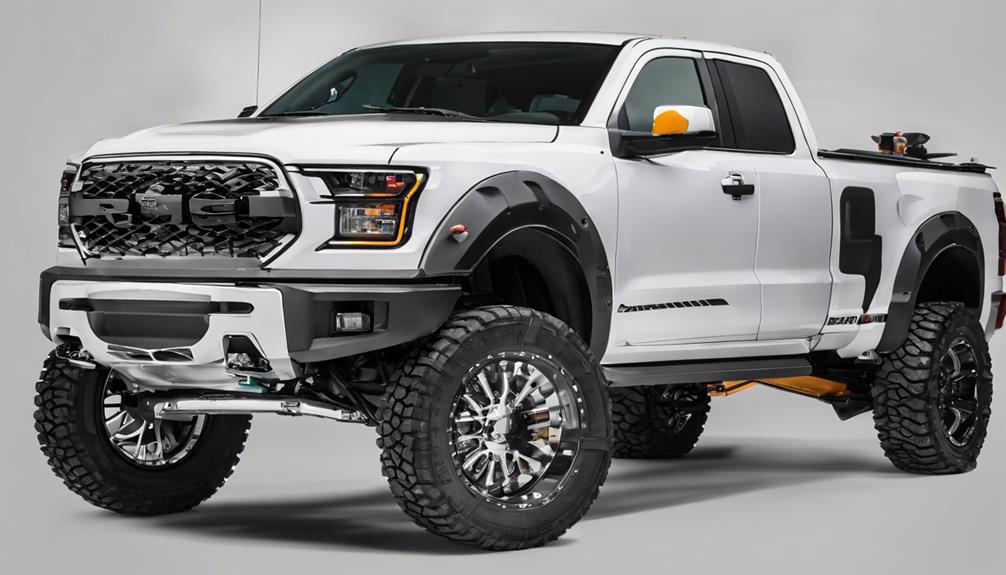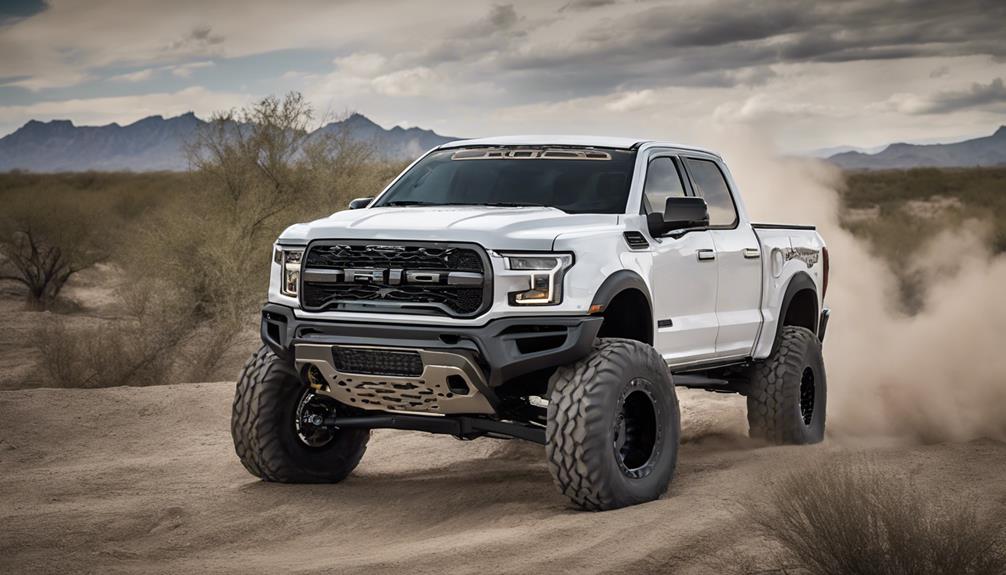If you're in Rio Grande Valley, did you know that custom truck lift kits are gaining popularity, with a 20% increase in installations over the past year alone? Understanding the ins and outs of selecting the right lift kit for your truck can make a significant difference in both performance and style. From maximizing tire size to enhancing off-road capabilities, the possibilities are endless. Stay tuned to discover essential tips that can help you navigate the world of custom truck lift kits in Rio Grande Valley and make informed decisions for your vehicle's upgrade.
Key Takeaways
- Prioritize safety, legal compliance, and maintenance for optimal custom truck lift kit performance.
- Consider costs, benefits, and long-term implications before choosing a lift kit.
- Verify compatibility, weight capacity, and conduct alignment checks regularly.
- Seek professional installation for precise fitment, alignment, and warranty protection.
Benefits of Custom Truck Lift Kits
Custom truck lift kits provide a significant boost in off-road performance and enhance the overall functionality of your vehicle. By increasing ground clearance, these truck lift kits allow you to tackle rough terrains with ease. The added height not only accommodates larger tires for improved traction but also enhances your visibility, giving you a better view for managing obstacles and monitoring your surroundings. This increase in ground clearance is essential for preventing undercarriage damage and improving your approach and departure angles, especially when conquering steep hills.
In addition, aside from the practical advantages, custom truck lift kits also offer a unique aesthetic appeal. Your vehicle will stand out from the crowd, reflecting your personal style and showcasing its enhanced capabilities. Investing in a custom truck lift kit can potentially boost the resale value of your vehicle, as it demonstrates both improved performance and a distinctive look. So, if you desire belonging in the off-road community and seek to elevate both your driving experience and your vehicle's appearance, a custom truck lift kit is a worthwhile addition.
Factors to Consider Before Installation
Considering the purpose of your vehicle is key when determining the most suitable lift kit for your specific needs. Understanding whether you require a lift for off-road adventures or simply for aesthetic purposes will guide your decision-making process. Budget evaluation is vital to make sure you can afford both the lift kit and any necessary modifications that may be required during installation. It is also important to consider the warranty implications of installing a lift kit, as some modifications can void existing warranties. Assess the complexity of the installation process and determine if professional installation is necessary for your specific lift kit to avoid complications. Additionally, take into account how the lift kit may impact your truck's ride quality and handling. By carefully considering these factors before proceeding with the lift kit installation, you can ensure a smoother and more successful customization process.
Choosing the Right Lift Kit Type

When selecting the right lift kit type, you should focus on the desired lift height and the suspension system of your vehicle. The lift kit height determines how elevated your truck will be, affecting its off-road capabilities and overall look. Understanding the different suspension system types available will help you make an informed decision on which lift kit best suits your off-road needs.
Lift Kit Height
Selecting the appropriate lift kit height is important for enhancing your truck's performance and ensuring safe operation across various terrains. Consider these key points when choosing the right lift kit height:
- Intended Use: Determine the purpose of your truck to select the best lift kit height.
- Body vs. Suspension Kits: Body lift kits offer minor adjustments, while suspension kits provide significant height increases for off-road capabilities.
- Tire Size: Make sure the lift kit height accommodates the tires you plan to install.
- Center of Gravity: The height affects stability and handling, important for turns and uneven surfaces.
- Specifications Matching: Properly match the lift kit height to your truck's details for safe operation on diverse terrains.
Suspension System Types
To determine the most suitable lift kit type for your truck's suspension system, evaluate the specific requirements of your intended use and desired performance enhancements. If your truck has coil spring suspension, a coil spring spacer lift kit can be a cost-effective option by spacing out the existing coil spring to provide lift. Shackle lift kits are designed for vehicles with leaf spring suspensions and lift the rear of the vehicle. For trucks and SUVs, block insertion lift kits insert blocks between the axle and leaf springs to achieve lift. Each of these lift kit types serves a specific purpose based on the suspension system of your truck, so choosing the right one will depend on your needs and preferences.
Professional Installation Vs. DIY
When considering professional installation versus a DIY approach for your truck lift kit, it's important to weigh the pros and cons. Professional installation guarantees precise fitment and alignment, backed by warranty protection and expertise in suspension tuning. On the other hand, opting for a DIY approach can save costs but demands mechanical knowledge and tools for a successful outcome.
Pros of Professional Installation
For ideal fitment, performance, and warranty protection, entrusting the installation of custom truck lift kits to professionals is highly recommended. Professional installation offers several advantages:
- Installation Expertise: Professionals make sure correct fitment, reducing compatibility risks.
- Warranty Protection: Many professional installations come with warranty coverage for peace of mind.
- Safety Assurance: Expertise in alignment and suspension tuning guarantees best safety.
- Precision and Quality Workmanship: Professional installation ensures accuracy and high-quality results.
- Specialized Tools and Knowledge: Recommended for those lacking mechanical skills and tools required for the job.
Opting for professional installation not only saves time but also guarantees a job well done, providing you with confidence in your custom truck lift kit setup.
Benefits of DIY Approach
If you're considering a DIY approach for installing your custom truck lift kit, understanding the benefits in comparison to professional installation is key to making an informed decision. DIY advantages include cost-effectiveness by saving on labor expenses and the personal satisfaction of completing the task yourself. However, to succeed, you must possess mechanical knowledge and have the necessary tools at hand. Safety precautions are paramount when undertaking a DIY installation to avoid accidents and ensure a secure fit. Common mistakes during installation include improper alignment and suspension tuning, which can impact your vehicle's performance. Having troubleshooting tips ready can help rectify these issues. Remember to follow a step-by-step guide and seek assistance if needed to achieve a successful DIY custom truck lift kit installation.
Cost Considerations
Consider the cost implications of opting for professional installation versus a DIY approach when installing custom truck lift kits in the Rio Grande Valley.
- Installation Costs: Professional installation may have higher upfront costs but includes warranty protection.
- Warranty Protection: Professional installation guarantees warranty coverage for the lift kit.
- DIY Challenges: DIY installation can lead to fitment issues and potential safety concerns.
- Fitment Issues: DIY installation requires precision to avoid fitment issues that can impact performance.
- Initial Savings, Long Term Performance: While DIY offers initial savings, professional installation can provide long-term performance benefits and reliability.
Maintenance and Care Tips
Inspect and tighten all bolts and hardware on your custom truck lift kit regularly to prevent loosening and potential issues. Keeping the lift kit components clean and free from dirt, debris, and rust is essential for longevity and performance. Check the suspension components for wear and tear, addressing any issues promptly to maintain peak functionality. Regular alignment checks are vital to preserve tire wear and guarantee proper handling and stability on the road. Follow manufacturer recommendations for maintenance intervals and procedures to uphold the warranty and maximize the lift kit's lifespan.
| Maintenance Tips | Care Recommendations |
|---|---|
| Regularly inspect bolts and hardware | Keep components clean and free from rust |
| Check suspension for wear and tear | Address issues promptly for peak functionality |
| Perform alignment checks regularly | Guarantee proper tire wear and stability |
| Follow manufacturer guidelines | Uphold warranty and maximize lifespan |
Legal Considerations for Lifted Trucks

Compliance with state laws governing lifted trucks is important to guarantee road safety and legal operation. When considering custom truck lift kits, it's essential to understand the legal requirements and modifications necessary for road legality. Here are some key points to keep in mind:
- Lifted trucks must adhere to state laws on maximum vehicle height to guarantee safety on the road.
- Some states mandate additional lighting, like marker lights, for lifted trucks to meet road-legal standards.
- Modifications such as extended brake lines may be necessary to maintain safe braking performance with a lifted truck.
- Aftermarket lift kits must meet specific safety standards to be considered legal for road use.
- Researching and understanding local regulations and inspection requirements is crucial before lifting your truck to ensure compliance.

No Responses